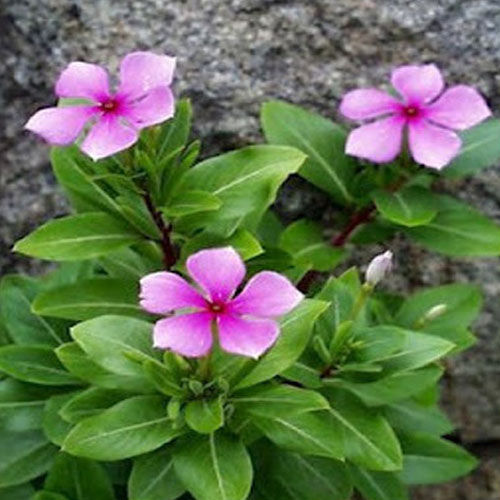Vinca Rose Plants
Vinca (also known as Periwinkle) is a genus of flowering plants known for their attractive, colorful blooms and glossy green foliage. Vinca is popular in gardens and as a houseplant due to its ease of care and long blooming period.
Features of Vinca Plants:
-
Flowers:
- Color: Vinca flowers come in various colors, including white, pink, purple, and red. Some varieties have a contrasting center or edge.
- Shape: Flowers are typically five-petaled and can be funnel-shaped or star-shaped.
- Blooming: Vinca plants bloom from spring through fall and can continue to flower well into the cooler months.
-
Growth Habit:
- Form: Vinca plants can be either upright or trailing, depending on the variety. They are often used as ground cover or in hanging baskets.
- Height: They typically grow between 6 to 12 inches tall. Trailing varieties can spread out over a larger area.
-
Leaves:
- Shape: Leaves are usually oval or lance-shaped and have a glossy texture.
- Color: They are generally green but can vary slightly depending on the variety.
Care Tips for Vinca Plants:
-
Sunlight:
- Light: Vinca plants prefer full sun to partial shade. They need at least 4-6 hours of direct sunlight daily to thrive and bloom well.
-
Soil:
- Type: They grow best in well-drained soil. A standard potting mix with added perlite or sand can improve drainage.
- pH: They are adaptable to a range of soil pH levels but prefer slightly acidic to neutral soil.
-
Watering:
- Frequency: Water regularly to keep the soil consistently moist, especially during dry periods. Allow the top inch of soil to dry out between waterings.
- Method: Water at the base of the plant to avoid wetting the foliage, which can lead to fungal diseases.
-
Fertilizing:
- Type: Use a balanced, water-soluble fertilizer. Feed every 4-6 weeks during the growing season to support healthy growth and blooming.
- Timing: Reduce feeding in the fall and winter when the plant's growth slows down.
-
Pruning:
- Purpose: Regularly deadhead spent flowers to encourage continuous blooming. Prune back any leggy or overgrown stems to maintain a compact and attractive shape.
- Timing: Prune after the main blooming period or as needed throughout the growing season.
-
Pest and Disease Control:
- Pests: Watch for common pests like aphids, spider mites, and whiteflies. Treat with insecticidal soap or neem oil if necessary.
- Diseases: Ensure good air circulation and avoid overhead watering to prevent fungal diseases like powdery mildew and downy mildew.
Uses and Benefits:
- Ornamental: Vinca is popular for garden beds, borders, hanging baskets, and containers. It’s also used as ground cover in both sunny and partially shaded areas.
- Low Maintenance: Their drought tolerance and ability to thrive in a range of conditions make them suitable for low-maintenance gardening.
If you have any specific questions about Vinca plants or need advice on where to purchase them, feel free to ask!


